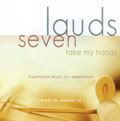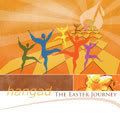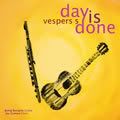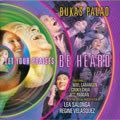The Jesuit Music Ministry (JMM), an official ministry in the Philippine Province of the Society of Jesus, traces its roots to the pioneering work of Fr. Eduardo Hontiveros SJ, who began composing Filipino liturgical songs in response to the mandate of Vatican II in the ‘60s. Vatican II’s
Sacrosanctum Concilium urged the entire assembly to actively participate in the liturgy which includes singing. From the first song Fr. Honti composed for a group of young boys and girls in Barangka,
Marikina to the songs composed by present generation Jesuits and lay partners, JMM songs have been sung in churches not only in the
Philippines but in the world.
The background of the Jesuit Music Ministry is Jesuit history itself. From the beginning of its missionary work, the Society of Jesus made its mark by contributing to Baroque music played in churches and sung even in Jesuit colleges. The first school of music in the Western Hemisphere was a Jesuit school in Sao Vicente in 1553. Mozart composed an opera for the Jesuit College in Salzburg. Giovanni Pierluigi da Palestrina was master of music from 1566 – 1571 at the Jesuit Roman College, now Gregorian University, in Rome.
But the biggest name is Domenico Zipoli SJ, an Italian Baroque composer who studied under Alessandro Scarlatti in Naples and played as an organist in the Church of the Gesu in Rome, and composed the famous, Sonate d'intavolatura per organo e cimbalo. He entered the Society of Jesus in 1716 and volunteered to be sent to the Jesuit mission in Paraguay where his musical expertise developed the musical talents of the Guarani Indians in the Paraguay Reductions. The Paraguay Reductions was made popular by the 1986 British film, The Mission, starring Jeremy Irons, Robert de Niro, Aidan Quinn and Liam Neeson, which showed Guaranis singing the music composed by the Jesuits who manage their community. Fr. Zipoli’s music has been discovered today in Chiquitos, Potosi and Sucre in Bolivia --- including masses, psalm settings, office hymns. Domenico continues to influence many composers that succeeded him.
The succeeding years after the mandate of Vatican II, the St. Louis Jesuits in the US responded effectively, appropriating their music to scriptural texts. We know these: “Sing A New Song (Psalm 98)”, “Yahweh, You are Near (Psalm 139)” and “Here I Am Lord (Isaiah 6)”. In the Philippines, the generation of composers inspired by Fr. Honti such as Frs. Fruto Ramirez SJ (“Purihin ang Panginoon”), Nemy Que SJ (“Mahal na Puso ni Hesus”), Charlie Cenzon SJ (“Awit ng Paghahangad”), Jboy Gonzales SJ (“Panunumpa”), Arnel Aquino SJ (“Ito ang Araw”) and Manoling Francisco (“Hindi Kita Malilimutan”) followed suit composing also inspirational melodies that draw insight from contemporary music.
Jesuits promoted the use of the arts especially in schools because they believed that schools were places of the imagination and of the senses. And thus, the arts particularly music, became part of Jesuit education. Ignatian spirituality holds that God can be found in all things, and that human creativity is of God and can be used for God’s glory. St. Ignatius placed a great role in the imagination and the senses, and believed that these can bring a person to God.
A case in point: An email was recently sent to JMM from Nico Lariosa of Australia: “I should say that the JMM-produced albums have helped me a lot in coming to understand God's unconditional love since I came across one copy of Himig Heswita in 1997. Ten years later, I still find myself strongly moved by the songs. I feel indebted to Hangad and Bukas Palad for making me aware of my vocation ten years ago through their music. God bless and keep the music playing. You don't know whom you are drawing to God through them.”
So the Jesuit Music Ministry continues the work of its predecessors. Today, JMM produces around 50 albums of vocal and instrumental religious music for use in prayer and worship even for easy listening and relaxation. People tell us that they use these songs to calm them when they are on the road. They find listening to our BukasPalad, Hangad, Himig Heswita and Noel Cabangon albums inspiring. And they use our instrumental albums such as Lauds, Vespers, and Matins series as effective aids to meditation and prayer. Our music and MTVs won awards at the Awit Awards and the Catholic Mass Media Awards (CMMA) and are regularly shown in local television channels.
Aside from producing music, JMM began expanding its services: training parish and school choirs, giving liturgical music seminars and staging concerts locally and abroad. BukasPalad organized a Choir Convention at the Ateneo de Manila High School with key speakers, Frs. Manoling Francisco SJ and Carlo Magno. Hangad held a vocal training workshop. Recently, JMM artists performed at Cubao’s Diocesan Youth Assembly at Christ the King Seminary, Quezon City and Fr. Jboy Gonzales SJ taught a class on liturgical music in the 3rd John Paul II Catechetics & Youth Ministry Conference at the Don Bosco Technical Institute in Makati City.
Just as the past Jesuits immediately responded to the needs of their age, the Jesuit Music Ministry now, while continuing its endeavors, hopes to respond more to the younger generation which comprises 51% of the population of the Philippines. We hope that through God’s grace we will be able to reach out to the youth through new music genres that would make them active participants in the liturgy.
Labels: albums, choir, filipino, fr. jboy, Jescom, jesuit, jmm, liturgical music, meditation, ministry, music, religious
 0
comments
|
Saturday, May 12, 2007
0
comments
|
Saturday, May 12, 2007










